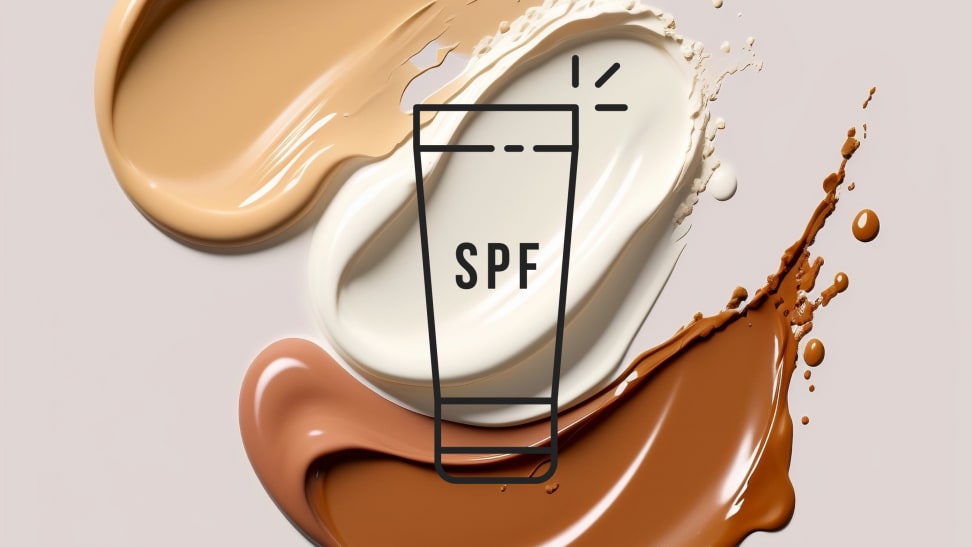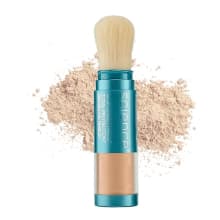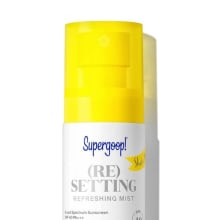Your makeup's SPF just isn't enough sun protection
Best practices for keeping your face flawless
 Credit:
Reviewed
Credit:
Reviewed
Products are chosen independently by our editors. Purchases made through our links may earn us a commission.
We all know by now that we should be using sunscreen everyday. If your typical day involves wearing makeup, you may dismiss SPF as an extra and unnecessary step. Please don't.
To think your face is protected from the sun by a layer of foundation is a myth—surprisingly, you’re not totally covered even if your foundation has SPF in it.
SPF makeup alone is not enough sun protection
SPF makeup provides some protection, says Tsippora Shainhouse, MD, a board-certified cosmetic and medical dermatologist based in Beverly Hills. She recommends not depending on your foundation as your primary source of UV protection.
“In order to achieve the sunscreen SPF on the makeup label, you would need to use seven times the thickness you would normally use if using liquid foundation, and 14 times the amount if using a powder foundation.”
That's probably not the look you’re going for.
How does SPF work?
SPF, or sun protection factor, relates to the sunscreen’s ability to block UVB light, the wavelength responsible for sunburns. The number indicates how well it does that and for how long.
For example, a product with SPF 15 blocks 93% of UVB rays. It will also increase the amount of time your skin can stay in direct sunlight without burning by a factor of 15. (If—without protection—your skin starts to burn in 10 minutes, SPF 15 increases that to 150 minutes.) A product with SPF 30 blocks 97%, and boosts sun exposure time by a factor of 30.
The sun also emits UVA rays, which are the ones linked to premature aging. The ability to block UVA rays isn’t represented by the SPF, so it’s best to choose a sunscreen labeled “broad spectrum” to ensure you’re covered against both types.
Joshua Zeichner, MD, is a board-certified dermatologist based at Mt. Sinai in New York City. He says, “The problem is that, in the real world, we are not applying as much sunscreen as we should, and we certainly are not reapplying, which means that the SPF value gets diluted out.”
For optimal protection, use broad-spectrum products containing a high SPF, and reapply every two hours (or even more frequently if you’re sweating or swimming).
Choose sunscreen products that work with makeup
To find a sunscreen that works best with your makeup, look for one that’s labeled “for face” and described as “non-comedogenic” to reduce your risk of acne breakouts. Ensure it includes a moisturizer if your skin requires it, so you can eliminate a step (more on that in a moment).
Another decision will be based on the type of active ingredient in the sunscreen. These fall into two categories, chemical and physical sunscreens.
Chemical sunscreens' active ingredients, such as avobenzone, octisalate, and oxybenzone, absorb into the skin and convert the sun’s UVA or UVB rays—different ingredients work for each—into heat, which is then released into the air. Chemical-based sunscreens have traditionally tended to absorb more fully into the skin and be more popular with makeup wearers for that reason.
Physical, or “mineral” sunscreens, containing zinc oxide and/or titanium dioxide, sit on top of the skin and create a film that physically deflects the rays from penetrating the skin’s surface. Makeup wearers previously shied away from physical sunscreens, as they tended to cause a white cast on the face. However, newer products have tiny “micronized” particles that smoothly apply to the skin and do not cause this ghostly effect.
Suzanne Friedler, MD, F.A.A.D, a board-certified dermatologist with Advanced Dermatology PC in New York City., says, “Often the most cosmetically elegant [SPF products] these days [contain] those micronized physical blockers.”
Regardless of active ingredient, choose one with a high SPF, even if your usual makeup contains SPF as well.
Shainhouse cautions, “Do not consider the sunscreen effect to be cumulative.” Wearing SPF 50 sunscreen and then wearing a foundation with SPF 15 does not create an SPF of 65. In fact, Shainhouse says layering a lower SPF over a higher one can even dilute the higher one, which is why starting high is a good plan.
Get your sunscreen and your makeup to play nice
When applying anything to your skin, the golden rule is to layer products from thinnest to thickest so that they are all able to effectively penetrate into the skin.
Shainhouse suggests washing and patting the face dry, applying any serums you use, followed by moisturizer, then sunscreen (or use a twofer moisturizing sunscreen, as described above). Once your skin is prepped with these steps, go about your makeup routine as normal. And don't forget about your scalp!
Look good while staying sun-safe all day long
As already mentioned, it’s important to reapply SPF every two hours, or at least before you head outside into the sun after you’ve been indoors a while.
As it’s impractical to wash your face and start from scratch, Shainhouse recommends those who want a matte finish touch up with an SPF-containing powder.


For people who prefer a dewy look, a setting spray infused with SPF, like this one is a good option for reapplying sun protection.


